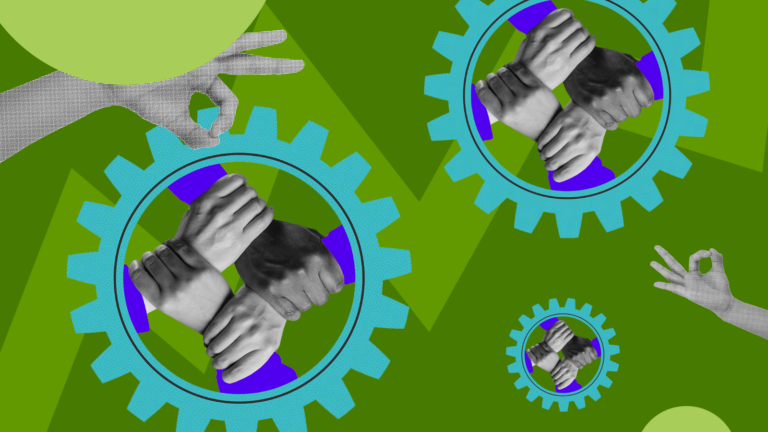
Garantizar la estabilidad de la organización y mitigar los riesgos con DevSkiller

Gestionar y mitigar riesgos como la erosión del conocimiento y la transferencia eficaz del mismo es vital para la estabilidad y el crecimiento de la organización. Las empresas deben afrontar estos retos para mantener una ventaja competitiva y fomentar la mejora continua.
DevSkiller se destaca entre sus pares como su socio estratégico para gestionar y optimizar las habilidades de su equipo, abordando directamente estos riesgos. Aprovechando la Plataforma DevSkiller, su organización puede gestionar eficazmente algunos de los mayores riesgos y garantizar su prosperidad gracias a la estabilidad organizativa.
Este artículo proporciona una guía paso a paso para que los profesionales de RRHH entiendan e implementen DevSkiller para la mitigación de riesgos. Exploraremos cómo DevSkiller puede integrarse en las prácticas de RR.HH. para agilizar la gestión del conocimiento, facilitar la transferencia efectiva del conocimiento y construir una organización resistente. marco organizativo.
Risk 1: Knowledge retention
Risk 2: Succession planning Risk
3: Onboarding new employees
Risk 4: Cross-training and skill diversification
Risk 5: Project continuity
Risk 6: Industry regulatory compliance
Risk 7: Lack of innovation and continuous improvement
By the end of this guide, you will have the tools and insights necessary to mitigate risks and ensure stable, sustainable growth for your organization.
Let’s start!
Risk 1: Knowledge retention
Retaining their knowledge as employees retire or leave is critical to maintaining organizational continuity and performance. Ensuring that the valuable expertise of experienced employees is captured and shared can help prevent knowledge gaps and promote ongoing growth and development within the company. Here’s our steps to overcoming this risk:
Step1: Implement of a skills management platform
Implementing a skills management platform is an effective way to document and map the skills and knowledge of experienced employees. This platform serves as a centralized repository where detailed profiles of employees can be created, capturing their skills, projects, and insights. By systematically documenting this information, your organization can ensure that critical knowledge is preserved and accessible to others.
Step 2: Create detailed employee profiles
A key action in this process is to create detailed profiles for experienced employees. These profiles should include comprehensive information about their skills, past projects, and unique insights gained throughout their careers. This documentation helps to create a valuable resource that can be referred to by current and future employees, ensuring that the expertise of seasoned professionals is not lost.
Step 3: Encourage knowledge sharing
To maximize the benefits of the skills management platform, it is important to encourage knowledge sharing through mentorship programs or internal training sessions. Experienced employees can be paired with less experienced colleagues to share their expertise and provide guidance.
Additionally, internal training sessions can be organized to facilitate the transfer of knowledge on specific topics or projects. Using the platform to coordinate and track these activities ensures that knowledge sharing is structured and effective.
Risk 2: Succession planning
Ensuring smooth transitions when key employees leave your organization is critical to maintaining operational stability and performance. Organizations can mitigate disruptions and ensure continuity by proactively identifying potential successors and preparing them for their future roles. Here’s how this risk can be overcome:
Step 1: Introduce successor identification and training
Identifying potential successors well in advance is a crucial step in preparing for smooth transitions. This involves recognizing employees who have the potential to fill key roles and providing them with the necessary training and knowledge transfer. By doing so, your organization can ensure that these successors are well-equipped to step into their new roles when the time comes.
Step 2: Track development using a skills management platform
A skills management platform can be instrumental in tracking the development of potential successors. This platform allows your organization to monitor the progress of employees identified as successors, ensuring they receive the appropriate training and opportunities to work with experienced employees. By systematically tracking their development, you can ensure that successors are gaining the skills and knowledge they need to succeed.
Step 3: Assign potential successors to experienced employees
Potential successors should be assigned to work closely with experienced employees to facilitate effective knowledge transfer. This mentorship arrangement allows successors to learn directly from those who have a deep understanding of the role and its responsibilities. Through hands-on experience and guidance, successors can acquire the practical skills and insights needed to perform effectively.
Step 4: Provide targeted training
In addition to mentorship, targeted training should be provided to bridge any carencias de competencias identified in potential successors. This training should be tailored to address the specific competencies required for the role, ensuring that successors are fully prepared to take on their new responsibilities. Regular assessments and feedback can help to refine this training and ensure it is meeting the needs of both the successors and the organization.
Risk 3: Onboarding new employees
Ensuring that new employees quickly acquire the necessary knowledge to perform their roles effectively is vital for organizational productivity and integration. A well-structured onboarding process can significantly enhance the speed and efficiency with which new hires become proficient in their roles. Here’s how to do it:
Step 1: Implement of a skills and knowledge repository
Using a skills management platform, your organization can provide new hires with access to a comprehensive repository of essential skills and knowledge from experienced employees. This repository serves as a valuable resource, containing documented processes, key insights, and best practices that new employees can refer to as they acclimate to their roles.
Step 2: Develop comprehensive onboarding programs
A key action in this process is to develop comprehensive onboarding programs that leverage the skills and knowledge repository. These programs should be designed to provide new hires with a clear understanding of their responsibilities, the skills required for their roles, and the organizational processes they need to follow.
Step 3: Access to documented processes
Onboarding programs should include access to documented processes that outline the standard operating procedures for various tasks. This documentation helps new employees understand the workflows and expectations associated with their roles, enabling them to perform their duties more effectively and efficiently from the outset.
Step 4: Conduct skills assessments
Incorporating skills assessments into the onboarding process allows your organization to evaluate the current capabilities of new hires and identify any areas where additional training may be needed. These assessments provide a baseline understanding of the new employees’ skills and help tailor subsequent training to address specific gaps.
Step 5: Provide mentorship opportunities
Mentorship opportunities are a crucial component of effective onboarding programs. Pairing new hires with experienced employees facilitates hands-on learning and provides new employees with a support system as they navigate their new roles. Mentors can offer guidance, answer questions, and share practical insights that accelerate the learning curve for new hires.
Risk 4: Cross-training and skill diversification
Reducing reliance on a few key employees is essential for enhancing organizational resilience and ensuring continuity. By diversifying skills across the team, your organization can mitigate the risks associated with over-dependence on individual employees and promote a more balanced and capable workforce. Here’s our step-by-step guide for overcoming this risk:
Step 1: Implement of cross-training programs
It is vital to identify critical skills that are currently concentrated in a few employees and create cross-training programs designed to distribute these skills more evenly across the team. Cross-training ensures that multiple employees are proficient in key areas, reducing the impact of any single employee’s absence.
Step 2: Identify skill concentrations and gaps
A skills management platform can be instrumental in identifying skill concentrations and gaps within the organization. By analyzing the data, organizations can pinpoint which skills are held by only a few employees and which areas may be lacking sufficient coverage. This insight is crucial for designing effective cross-training initiatives.
Step 3: Design and implement cross-training initiatives
Once the critical skills and gaps are identified, your organizations can design and implement cross-training initiatives. These programs should be tailored to address the specific needs of the organization, ensuring that employees are trained in the key areas where skill diversification is most needed. Cross-training can take various forms, including workshops, job rotations, and peer-to-peer learning sessions.
Step 4: Ensure proficiency in key areas
Cross-training initiatives aim to ensure that multiple employees become proficient in key areas. This reduces reliance on a few individuals and enhances the team’s overall skill set. By having a broader base of employees who are capable of performing critical tasks, your organization can improve their flexibility and responsiveness to changing demands.
Risk 5: Project continuity
Maintaining project continuity during unexpected employee departures is crucial for organizational stability and success. By having robust systems in place, your organization can ensure that remaining team members can quickly understand and take over responsibilities without significant disruption. Here’s how to do it:
Step 1: Ensure up-to-date skills and project documentation
To achieve seamless transitions, it is essential to maintain up-to-date skills and project documentation. Comprehensive and regularly updated documentation ensures that all necessary information is readily available, enabling team members to quickly get up to speed with ongoing projects and tasks.
Step 2: Regular project documentation updates
A key action in this process is to regularly update project documentation. This includes detailed records of project plans, timelines, deliverables, and any issues or decisions made along the way. Keeping this information current ensures that any team member stepping into a new role can easily understand the project’s status and requirements.
Step 3: Update skills profiles in the platform
In addition to project documentation, it is important to regularly update skills profiles in TalentBoost. These profiles should reflect the current capabilities and experiences of each team member, providing a clear picture of who has the necessary skills to take over specific tasks or roles. This data is invaluable for making informed decisions during transitions.
Step 4: Facilitate seamless transitions
By using the updated project documentation and skills profiles, your organization can facilitate seamless transitions when employees leave unexpectedly. This information allows managers to quickly identify suitable replacements and ensures that these individuals have access to all the information they need to assume their new responsibilities effectively.
Risk 6: Industry regulatory compliance
Ensuring compliance with industry regulations is essential for mitigating operational risks and maintaining organizational integrity. Compliance with regulations not only protects your organization from legal and financial penalties but also enhances its reputation and operational efficiency. Here’s how to mitigate this risk:
Step 1: Introduce compliance tracking
To ensure that employees possess the necessary certifications and skills to comply with industry standards and regulations, it is important to implement a robust tracking system. This system should monitor and verify that all employees meet the required compliance criteria, helping to maintain a high standard of operation.
Step 2: Monitor compliance-related skills and certifications
A key action in this process is to use TalentBoost to monitor compliance-related skills and certifications. Our platform provides a centralized and up-to-date record of all employees’ certifications, training, and compliance statuses. By maintaining this information in an organized and accessible manner, organizations can quickly identify any gaps or areas needing attention.
Step 3: Provide alerts and training opportunities
The platform should also be configured to provide alerts and notifications regarding compliance requirements. These alerts can remind employees and managers when certifications are nearing expiration or when new regulatory standards are introduced. Additionally, TalentBoost can highlight training opportunities and resources to help employees maintain their compliance.
Step 4: Ensure continuous compliance
Ensuring continuous compliance involves regular monitoring and proactive management of compliance-related activities. This includes scheduling periodic reviews of compliance statuses, updating training programs to reflect the latest industry standards, and ensuring that all employees are aware of and adhere to regulatory requirements.
Risk 7: Lack of innovation and continuous improvement
Fostering a culture of innovation and continuous improvement is essential for staying competitive and achieving long-term success. By leveraging the collective knowledge of your organization, you can encourage the sharing of best practices and innovative ideas that drive growth and efficiency. Here’s how to do it:
Step 1: Ensure consistent knowledge-sharing
Encouraging the sharing of best practices and innovative ideas requires a structured approach to knowledge sharing. Creating platforms and opportunities for employees to exchange insights and solutions can significantly enhance your organization’s ability to innovate and improve continuously.
Step 2: Create forums and knowledge bases
A key action in this process is to use TalentBoost to create forums and knowledge bases. These digital spaces serve as centralized repositories where employees can share their insights, best practices, and innovative solutions. By facilitating easy access to this collective knowledge, your organization can promote collaboration and the continuous exchange of ideas.
Step 3: Encourage participation and engagement
To maximize the benefits of these forums and knowledge bases, it is important to encourage active participation and engagement from all employees. This can be achieved by recognizing and rewarding contributions, and integrating knowledge sharing into your organization’s culture. Encouraging cross-functional collaboration can also lead to the generation of diverse and creative solutions.
Step 4: Promote continuous improvement
Using DevSkillerto share best practices and innovative ideas promotes a culture of continuous improvement. Employees can learn from each other’s experiences and apply proven solutions to their own challenges. This not only improves individual and team performance but also contributes to the overall advancement of the organization.
Última palabra
Implementing our platform in your organization not only optimizes talent management but also significantly mitigates risks associated with knowledge erosion and transfer. This leads to better operational continuity, compliance, and fosters a culture of continuous improvement.
To capitalize on these advantages, start by conducting a thorough assessment of your current knowledge management processes. Identify key areas where DevSkiller can fill gaps and enhance efficiency. Ensure your team is well-trained on the platform and establish regular check-ins to measure progress and make necessary adjustments. Start leveraging DevSkiller today to transform your risk management and ensure seamless knowledge transfer. Visit DevSkiller to learn more and schedule a demo.




